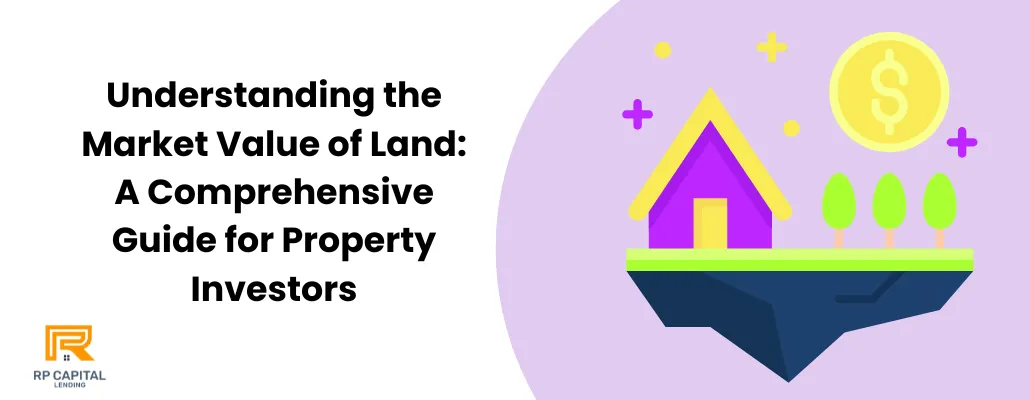Blog

Understanding the Market Value of Land: A Comprehensive Guide for Property Investors
The market value of land is a crucial factor for investors, developers, and homeowners. Whether you are buying, selling, or developing land, understanding its market value ensures you make informed decisions and maximize returns. But what exactly determines the market value of land, and how can you estimate it accurately?
In this guide, we’ll explore the key factors that influence land value, the methods for assessing it, and why knowing the market value is important for both buyers and sellers.
What is the Market Value of Land?

The market value of land refers to the estimated amount a parcel of land would sell for in the open market. This value is determined by a combination of factors, including location, demand, land use, and economic conditions. It's different from the land's assessed value (used for tax purposes) and appraised value (used in property financing).
Factors Influencing the Market Value of Land

1. Location
One of the most important factors in determining land value is location. Land in urban areas, especially near amenities such as schools, hospitals, and commercial centers, tends to have a higher value than rural or remote areas.
2. Zoning and Land Use
Zoning laws, which dictate how the land can be used (residential, commercial, agricultural), significantly impact its market value. For example, a parcel zoned for commercial use in a bustling city center will typically be more valuable than agricultural land in the countryside.
Fact:
"Zoning laws can increase land value in urban and suburban areas, as shown in a study by the Lincoln Institute of Land Policy. Properties with favorable zoning for commercial or residential use see higher market value" (Source: Lincoln Institute of Land Policy).
3. Economic Conditions
The broader economy influences the market value of land. In times of economic growth, land prices tend to rise as demand increases. Conversely, during recessions, land values may drop due to reduced demand.
4. Size and Shape of the Land
Larger parcels generally have a higher market value, but the shape of the land also matters. A perfectly rectangular or square plot is often more desirable than irregularly shaped plots, which may be harder to develop.
5. Access to Infrastructure
Land that is close to essential infrastructure—like roads, electricity, water supply, and sewage systems—has a higher market value. Easy access to transport routes, highways, and public transit is particularly valuable in urban areas.
6. Environmental Factors
Natural features, such as rivers, forests, or mountains, can increase land value if they enhance the aesthetic appeal or usability of the property. However, environmental risks like flood zones or poor soil quality can negatively impact the market value.
Fact:
"Environmental risks, such as flood zones or poor soil quality, can negatively impact the market value of land. According to the Environmental Protection Agency, these factors significantly reduce property desirability" (Source: EPA).
How to Estimate the Market Value of Land
There are several methods used by professionals to estimate the market value of land:
1. Sales Comparison Approach (SCA)
The most common method, SCA compares the land to similar parcels that have recently been sold. This approach is highly effective in stable markets where there are many comparable sales.
2. Income Approach
For commercial properties, the income approach estimates land value based on the potential income the property could generate. This method is particularly useful for investors looking at rental or lease opportunities.
3. Cost Approach
This method estimates the land’s value based on the cost of acquiring a similar parcel and the cost of developing the land. It’s useful when the land is vacant or underdeveloped.
4. Automated Valuation Models (AVMs)
In today’s digital age, many investors use AVMs—software programs that use algorithms to estimate property value based on various factors like recent sales, tax assessments, and market trends.
Why Knowing the Market Value of Land is Important
1. Accurate Pricing
If you're selling land, understanding its market value helps you set a competitive price that attracts buyers while maximizing your profits.
2. Investment Decisions
Investors rely on market value estimates to determine if a piece of land is a good investment. Overpaying for land can reduce your return on investment, while underestimating its value can lead to missed opportunities.
3. Property Development
Developers need accurate land valuations to budget their projects effectively. Land that is undervalued may seem attractive at first, but if development costs are too high, the project could become unprofitable.
4. Property Taxes
Knowing the market value of land is also essential for property tax assessments. An overestimated value can lead to higher taxes, while understanding its true value can help you contest unfair assessments.
Current Trends in Land Market Values (2024)
In 2024, several trends are impacting the market value of land globally:
1. Urbanization
As more people move to cities, land in urban areas continues to increase in value. However, suburban and rural land near expanding metropolitan areas is also seeing a rise in market value.
Fact:
"Land prices in urban areas have risen by 20% in the last five years due to increased urbanization and demand, making it essential for investors and developers to understand the current market value trends" (Source: National Association of Realtors).
2. Environmental Sustainability
Land that is environmentally sustainable, such as properties equipped with solar panels or near renewable energy sources, is becoming more desirable and thus increasing in value.
3. Remote Work
The rise in remote work is affecting land values, as people seek to live in more affordable or scenic rural areas while maintaining their jobs online.
Example of Market Value Trends
The chart below shows the average land value increase over the last 10 years in urban, suburban, and rural areas:

Conclusion: Maximizing Your Investment by Understanding Land Value
Knowing the market value of land is essential for anyone involved in real estate. Whether you are buying or selling, an accurate understanding of land value will guide you in making better decisions. It can also help you anticipate future trends and developments in the real estate market.
To stay updated on land market trends and make the best investment decisions, it's advisable to regularly consult with real estate professionals and use online tools for property valuations.
Frequently Asked Questions (FAQs)
Q1: What is the best method to determine the market value of land?
The Sales Comparison Approach is the most common and reliable method, comparing the land to similar properties recently sold in the area.
Q2: Can I estimate the market value of my land online?
Yes, several online tools and Automated Valuation Models (AVMs) can help you estimate the market value based on recent sales, property data, and market conditions.
Q3: How often does land value change?
Land value can change frequently depending on economic conditions, local market trends, and factors like zoning changes or infrastructure developments.
Q4: What factors can decrease the market value of land?
Environmental risks like flood zones, poor soil quality, or lack of access to essential infrastructure can reduce the market value of land.
Q5: Is land a good investment in 2024?
Yes, land remains a strong investment, especially in urban and suburban areas experiencing growth due to urbanization and increasing demand for housing and commercial developments.
Also Read:
How to Calculate Square Feet of a House: A Complete Guide
RP Capital Lending is a d.b.a of RP Capital Partners Inc (NMLS # 2469193) | Privacy Policy
Copyright © 2022. All Rights Reserved.
Disclaimer: Loans only apply to non-owner occupied properties. Rates, terms and conditions offered only to qualified borrowers, may vary upon loan product, deal structure, other applicable considerations, and are subject to change at any time without notice.

